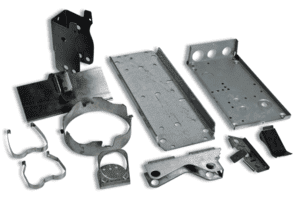Saving Money on Your Stamped Metal Parts
At ESI, we have a deep understanding of the challenges our clients face in their industries. We are dedicated to helping them reduce costs on stamped metal parts without compromising quality. With over 30 years of experience, we’ve continuously evolved our engineering solutions and manufacturing capabilities, incorporating advanced automation to meet the high standards of industries like automotive — where precision, speed, and reliability are essential.
Reducing the cost of stamped metal parts doesn’t mean sacrificing performance or quality. Here are three key areas you can review and optimize to achieve real savings:
Material Selection
The choice of material plays a huge role in the overall cost of stamped parts. Even small changes in material properties can affect the difficulty of stamping. For example, harder materials require more energy and time to form, increasing production costs. However, by choosing a softer or less abrasive material that still meets your part’s specifications, you can significantly cut costs while maintaining quality. Some materials may be cheaper but still offer comparable strength and durability, making them a smart alternative.
Additionally, if your design originally required a specific material due to its unique properties, but the minimum performance requirements have since changed, switching to a more cost-effective option could be both safe and beneficial. Always evaluate current market prices and material availability when making these decisions.
Tooling Design and Maintenance
Tooling is a major factor in metal stamping costs. Small design changes can lead to significant differences in tooling complexity, which directly affects production time and expenses. For instance, square holes require more machining than round ones, so simplifying such features can save money and improve efficiency.
It's also important to assess which design elements cause frequent downtime or wear on the stamping die. Complex notches or sharp corners can accelerate tool fatigue and increase maintenance needs. If these features are necessary, consider adjusting your maintenance schedule or using higher-quality tooling materials to extend life and reduce rework.
Production Volume Optimization
As demand increases, optimizing production volume becomes crucial. Larger orders often allow for design improvements that make parts easier to manufacture, reducing both time and cost. If you're working with prototype designs, now is the time to look for ways to simplify components while maintaining functionality and meeting cost targets.
Material and finishing costs tend to decrease with larger volumes, so consider placing bulk orders over time with smaller, scheduled releases. This helps manage inventory while securing better pricing from suppliers.
Understanding your Estimated Annual Usage (EAU) is also key. Based on how often and how many parts you produce, there may be opportunities to use different tool materials, coatings, or even multi-cavity tooling to further reduce costs. Adjusting the thickness or type of material used can also extend die life and lower material expenses.
In some cases, if your production volume exceeds expectations, you may need additional tooling to keep up with demand. Sharing your projected volume early with your stamping partner ensures they can plan accordingly and avoid costly delays or extra tooling costs.
Quality and Cost-Effective Metal Stamping
By carefully reviewing your materials, tooling needs, and production volume, you can significantly reduce the cost of stamped metal parts without compromising on quality. ESI has the expertise to guide you through every step of the process, ensuring that your parts meet industry standards while keeping expenses under control.
Contact the ESI team today to get a detailed quote and explore how we can help you streamline your metal stamping operations and achieve long-term cost savings.
Soft Ice Cream Machine,Ice Cream Machine Rental,Heavy Duty Ice Cream Machine,Commercial Soft Ice Cream Machine
JIANGMEN PRO-TAYLOR REFRIGERATION CO., LTD. , https://www.protaylor.com

Comments are closed